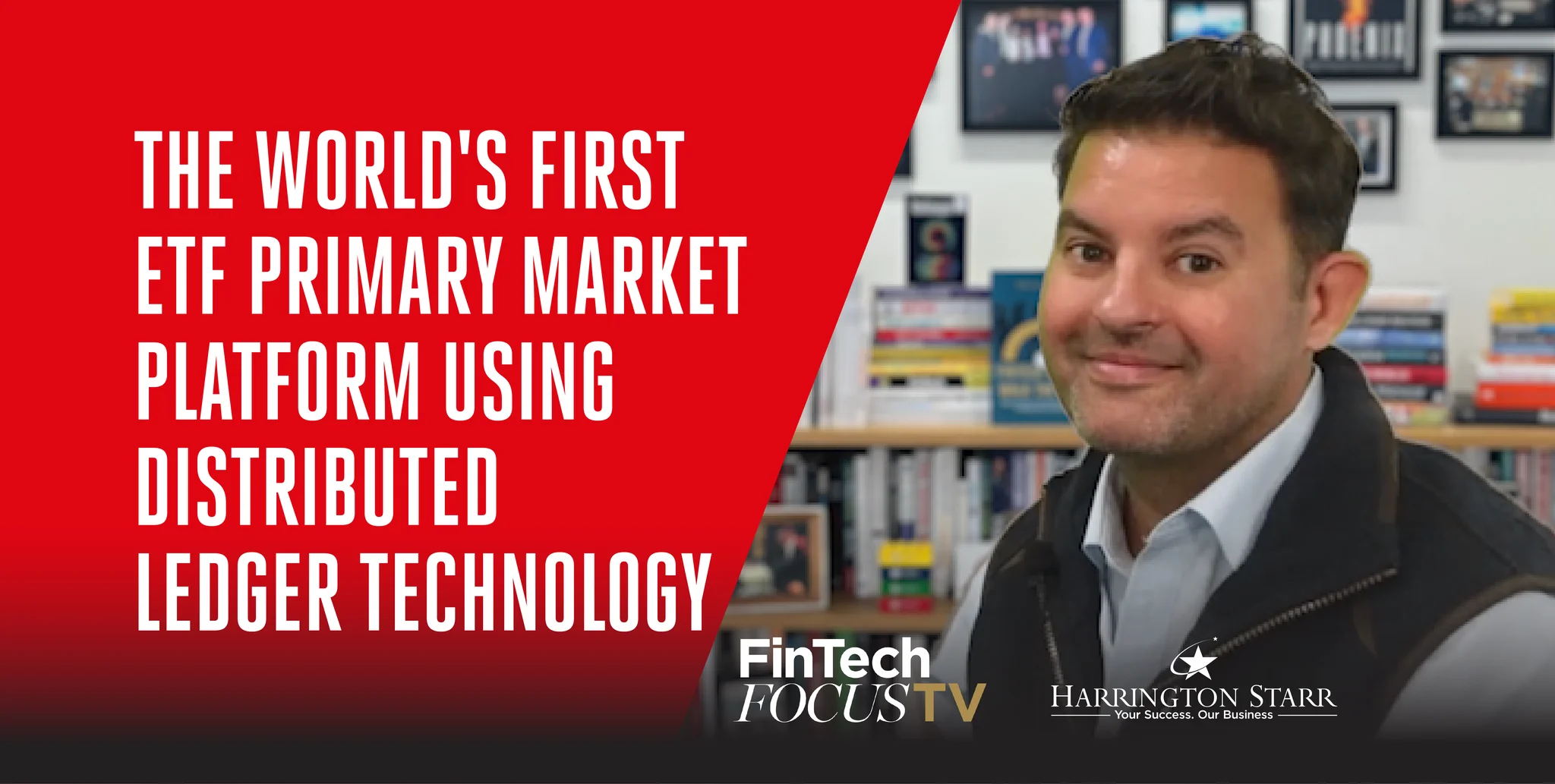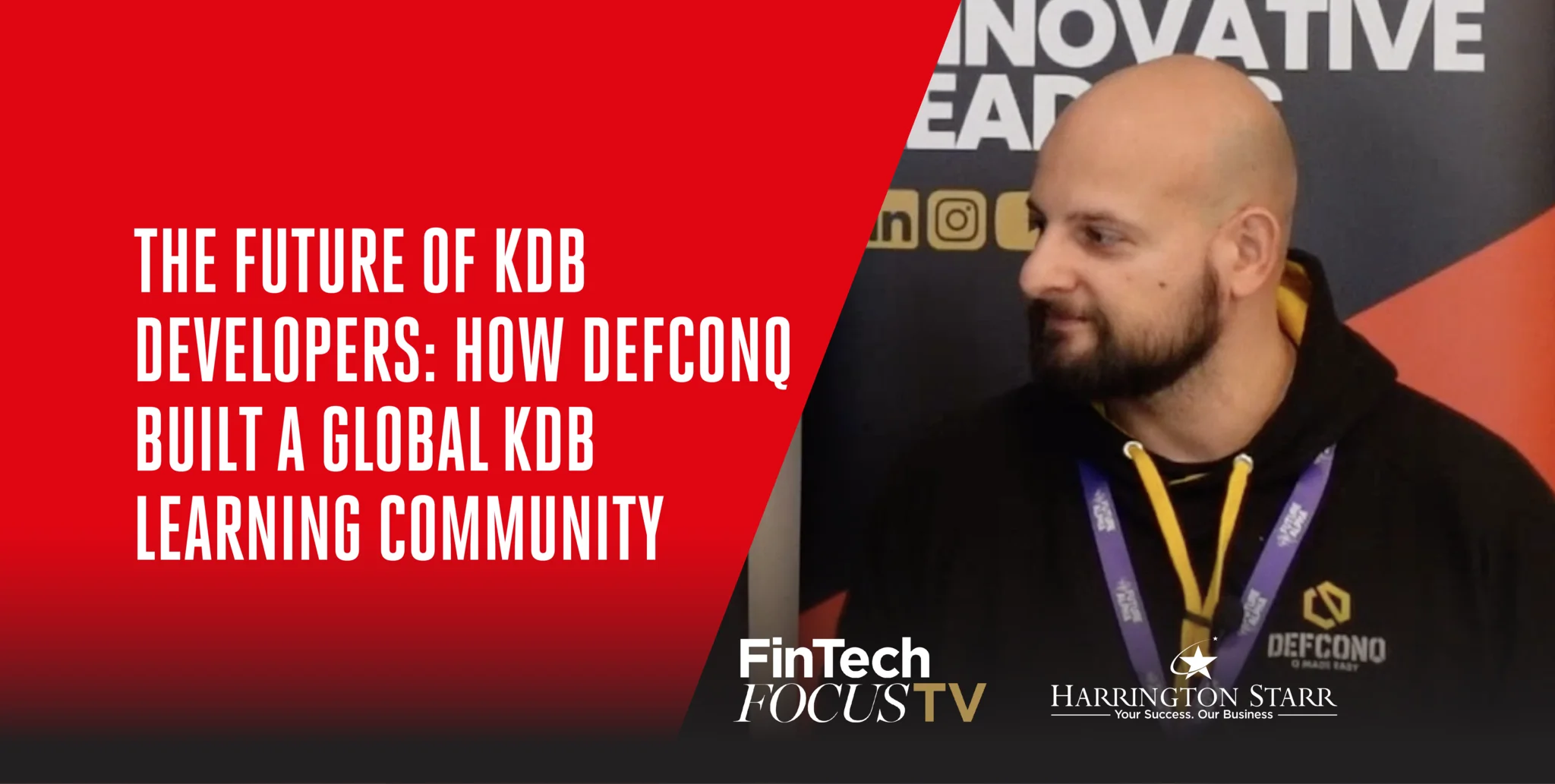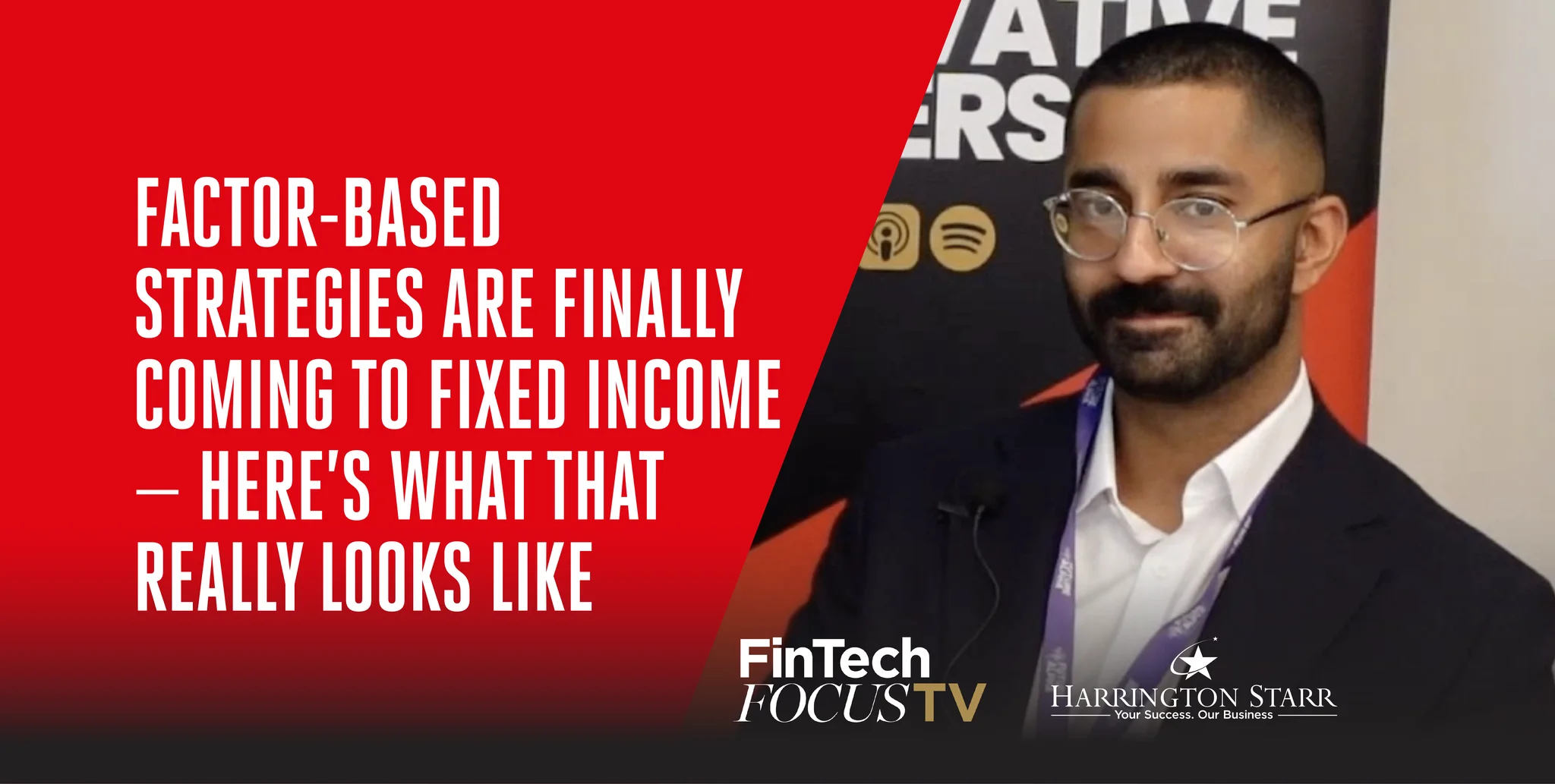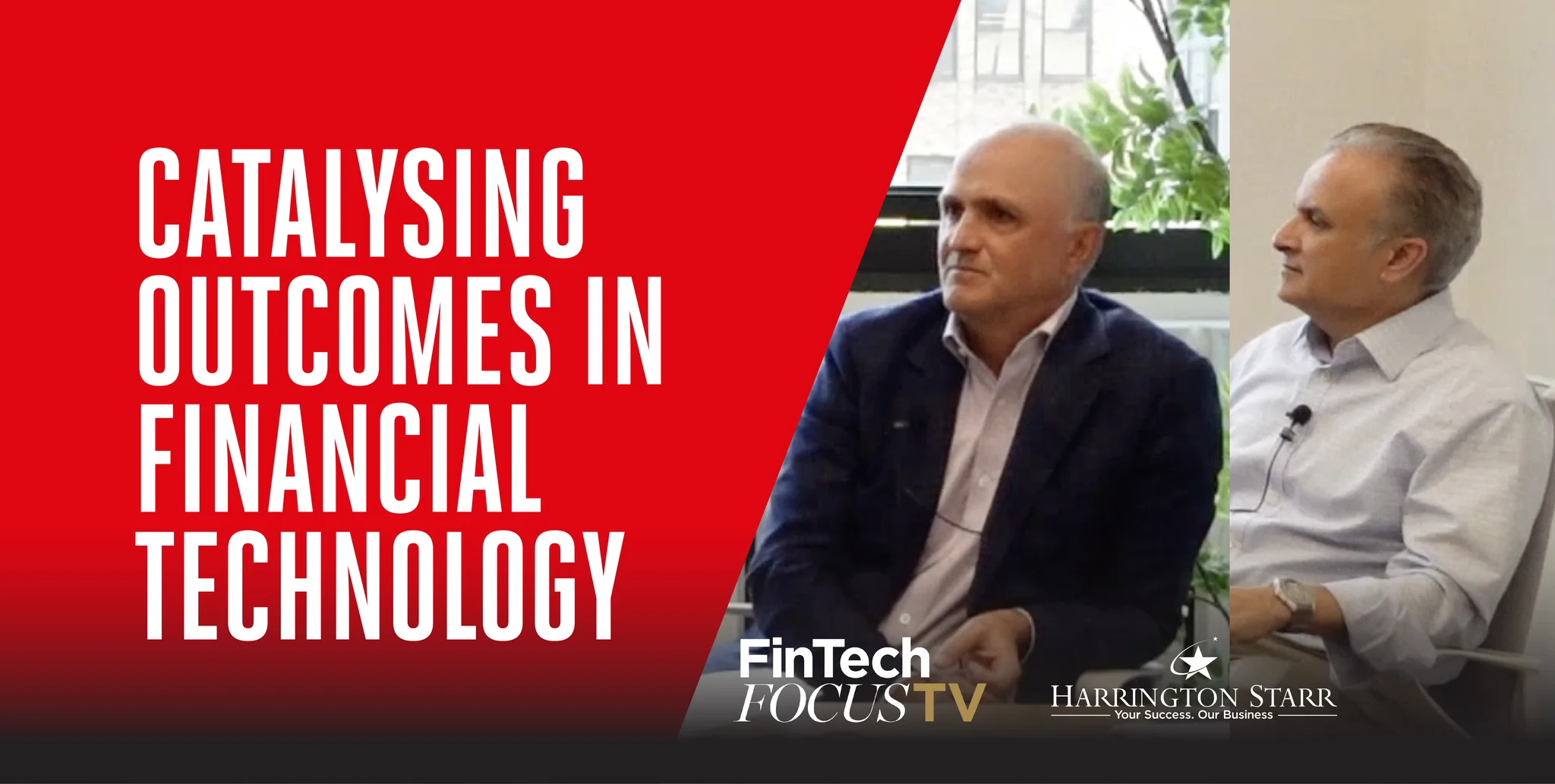ETPLink, DLT and the Future of ETF Infrastructure
In this episode of FinTech Focus TV, Toby welcomes Roger Balch, Chief Commercial Officer at ETPLink, to discuss one of the most pressing issues in financial technology: the inefficiencies within the ETF primary market. In a detailed and insightful conversation, Roger explores how ETPLink is working to automate and standardise ETF creation and redemption processes using distributed ledger technology (DLT) and smart contracts.
As a specialist FinTech recruitment firm, Harrington Starr is always interested in showcasing technology pioneers and the people leading change across capital markets. This episode offers rich insights into how innovation is reshaping the ETF landscape, and what that means for the future of financial services and the talent required to sustain that transformation.
Building a Platform to Transform the ETF Creation Process
Toby begins the episode with genuine excitement, recalling how impressed he was when he first met Roger. He was struck by Roger’s clear passion for the work he does and the vision behind ETPLink. That passion is evident from the outset as Roger introduces both himself and the company.
ETPLink was founded in late 2021, with the platform going live in 2022. Roger, as Chief Commercial Officer, explains that the company's mission is to homogenise and standardise the ETF create and redeem process, utilising DLT and smart contracts to achieve this. Their goal is to tackle a space in capital markets that is currently fragmented, inefficient, and often overlooked.
Roger shares some staggering figures: the ETF industry now comprises nearly 15,000 products from over 800 providers, managing approximately 15 trillion in assets. With such rapid growth, many traditional mutual fund managers are entering the space to access new investor audiences, particularly by leveraging the ETF wrapper for active strategies.
However, he points out that the underlying technology that supports ETF operations has not kept pace with this expansion. While the secondary market is relatively well-automated, allowing everyday investors to buy ETFs via brokers or exchanges, the primary market, where creations and redemptions occur, remains clunky and inconsistent.
The State of ETF Infrastructure in Global Capital Markets
Roger breaks down how ETF orders typically flow through the system. When investors make ETF purchases, those trades often face market makers, who in turn may need to create new units through the fund to meet settlement requirements. This brings us into the domain of the ETF primary market, a crucial but technologically underdeveloped segment of the industry.
In Europe alone, there are over 90 ETF issuers. The largest of these often operate their own proprietary platforms for creation and redemption. Smaller and mid-sized issuers, however, usually rely on custodians, who offer bundled services that include such platforms. This has led to a proliferation of different platforms, making it harder for authorised participants (APs) to manage their ETF instructions efficiently.
ETPLink aims to change that. The company is building a single point of access, a user interface and API, that will aggregate, automate and streamline the create/redeem process. Their vision is not just to improve operations for APs, but also to deliver adaptable and forward-looking solutions for issuers and custodians alike.
The situation is just as fragmented outside Europe. Roger notes that in the US and APAC regions, similar inefficiencies exist. In some cases, instructions are still facilitated by email, underlining the outdated nature of the current infrastructure.
Using Distributed Ledger Technology to Modernise ETF Operations
Toby is keen to explore the tech powering ETPLink’s ambitious platform. Roger proudly explains that they are building the world’s first DLT-based platform for ETF creation and redemption. Their enterprise-grade DLT foundation brings the well-known benefits of blockchain technology, immutability, auditability, consensus mechanisms, and customisation.
The real advantage, however, lies in their ability to provide bespoke solutions to individual clients. Through the use of subnets and private channels, ETPLink can tailor specific features to each client’s needs. Unlike traditional database systems, where any change impacts the whole platform, ETPLink’s infrastructure allows for client-specific innovation without affecting others.
This kind of flexibility is increasingly important in FinTech, where firms are seeking customisable tools that scale. As a FinTech recruiter, Harrington Starr sees growing demand for engineers and product professionals who understand DLT not just as a concept, but as a practical solution.
Positioning for T+0 and the Future of Financial Services
Toby and Roger discuss how the industry is evolving toward shorter settlement cycles, and how ETPLink is positioning itself for a T0 future. With the US moving to T+1 and Europe expected to follow by 2027, the prospect of same-day settlement is no longer hypothetical, it’s fast becoming the next standard.
Roger argues that DLT will likely be required to facilitate T0 settlements. Since ETPLink is already built on that foundation, the platform is well-prepared to operate in a world of instantaneous settlement. More than that, DLT allows for cross-ledger interoperability, enabling seamless operations across financial systems.
Importantly, Roger notes that users of their platform don’t see the DLT foundation, it simply operates like a high-performing ETF platform. However, it’s that hidden technological backbone that provides enhanced security and performance, laying the groundwork for future innovation.
From Institutional Finance to FinTech Start-Up
Toby asks Roger what led him to leave a career in institutional finance, having worked at the London Stock Exchange and in prime brokerage, to join a start-up. Roger explains that the decision was driven by a few key factors.
First, there is widespread recognition in the industry that the ETF primary market is broken. Everyone knows the problem exists, but few have taken concrete steps to fix it. For Roger, it was an opportunity to be part of a solution to a real and recognised issue.
Second, he joined a team with deep ETF experience and excellent technologists. The co-founders had traded ETFs in both primary and secondary markets and understood the pain points first-hand. Combined with a background in exchanges and financial operations, this made for a compelling team dynamic.
Roger reflects that it was a big leap to make, but he’s found the transition incredibly rewarding. They’ve already onboarded nearly 40 counterparties and are just getting started. His enthusiasm for the work is infectious, and it’s clear that the mission aligns with his personal drive.
The Growing Appeal of ETFs to a New Generation of Investors
As the conversation shifts back to the ETF market, Roger outlines why ETFs are becoming more popular. They offer transparency, liquidity, cost efficiency, and tax benefits, all of which are increasingly valued by modern investors.
He highlights that younger investors in particular are showing a strong interest in ETFs. Their simplicity and efficiency make them an attractive alternative to traditional mutual funds. This has led to a proliferation of actively managed ETF products and more mutual fund managers entering the space.
The growth of ETFs means that supporting infrastructure must scale, and that scaling requires smart recruitment. The need for engineers, product leads, and infrastructure specialists with ETF experience is rising. At Harrington Starr, we’re already seeing increased demand in this area from both start-ups and established institutions.
Going Global: The Future of ETPLink’s Expansion
Toby asks about the growth of ETPLink and where they’re heading next. Roger shares that the company is currently working with almost 40 counterparties and has an exciting project in APAC. In the coming year, they plan to enter new regions, with North America high on their list.
One of the advantages of DLT, Roger says, is its 24/7 uptime, which perfectly suits the global nature of the ETF industry. ETPLink’s infrastructure can operate across time zones and jurisdictions, offering flexibility that legacy systems simply cannot match.
The diversity of organisations they work with, from issuers and APs to custodians, fund administrators, and exchanges, demonstrates how central the platform is becoming within the ETF ecosystem. It echoes Roger’s earlier experience at the London Stock Exchange, where being at the heart of the market meant working with a wide variety of participants.
Why ETPLink Is the Platform of Choice
Toby poses the million-pound question: with competition out there, why are clients choosing ETPLink?
Roger credits the deep ETF experience within the team as a primary factor. Many of his colleagues have over 20 years of experience in the industry, working across ETF structuring, operations, and trading. The co-founders, in particular, have firsthand knowledge of the challenges facing ETF traders and market makers.
Coupled with that is the strength of their technology. The platform offers customised solutions, rapid feature deployment, and a modern architecture that is future-proofed for industry changes. This combination of expertise and technology is helping them win clients and gain trust in a complex marketplace.
At Harrington Starr, we know that building the right team is essential to FinTech success. Roger’s comments reinforce that it’s not just about having a great product, it’s about having the right people behind it. As firms seek to build and scale innovative solutions, hiring the right talent becomes a key competitive differentiator.
Creating Operational Efficiency in Capital Markets
The conversation closes on an important note. Roger explains that ETPLink isn’t just about building cool tech. Their mission is to help clients do more with less. In a world where margin compression is real, particularly in ETFs, firms need platforms that create operational efficiency.
ETPLink allows its clients to focus on what they do best, launching and managing innovative products, while the platform handles the plumbing behind the scenes. By automating and standardising ETF operations, they reduce friction, minimise errors, and enable scale.
This focus on efficiency, transparency, and trust aligns perfectly with the broader goals of modern capital markets and reflects the kind of FinTech transformation we support every day as a recruitment partner.
At Harrington Starr, we connect innovative companies with the best talent in financial technology. Whether you're building DLT infrastructure, transforming ETF platforms, or leading operational change, we can help you find the people who will make it happen.
Harrington Starr is a leading global FinTech recruitment firm specialising in connecting top talent with innovative companies across the financial services and technology sectors. With offices in London, New York, and Belfast, we partner with start-ups, scale-ups, and global institutions to deliver expert recruitment solutions across areas such as quantitative finance, software engineering, data, DevOps, infrastructure, cyber security, product, and sales & marketing. Our deep industry knowledge, consultative approach, and commitment to long-term relationships have made us a trusted advisor in the FinTech space. Whether you’re looking to grow your team or find your next opportunity, Harrington Starr is your go-to partner in FinTech recruitment.






